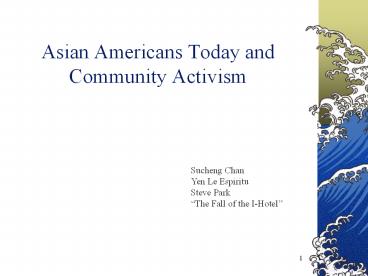1 PowerPoint PPT Presentation
1 / 18
Title: 1
1
Asian Americans Today and Community Activism
Sucheng Chan Yen Le Espiritu Steve Park The Fall
of the I-Hotel
2
Assignment for Thursday1. Reading Espiritu and
Park2. Bring in or identify something that you
think is an example of an Asian American cultural
production (art, music, performance, video,
cartoons, etc.) to share with the class . . . You
will be invited to share what it is and relate it
to ideas from the readings.
3
What are the five largest Asian ethnic groups in
the U.S. in the order of their population size?
4
How does the population of Asian Americans
compare with that of other ethnic/racial
minorities in the U.S.? CA?
5
Median Family Income By Ethnic Group
6
Median Family Income by Ethnicity and Gender
7
Poverty Rates
8
Per Capita Income
NHPI is abbreviated for those who identified
themselves as Native Hawaiian/Pacific
Islander Table 1. Per Capita Income by Ethnicity
in 1999 Source U.S. Census Bureau Summary File
4, SF4-PCT 130. http//www.aamovement.net/viewpoin
ts/ninjasdragons2.htm
9
Contemporary Issues (Chan)
- Model minority myth critique similar to Mia
Tuans debate is partly over economics, partly
over ideology (167-171) - College admissions anti-Asian bias
- Asian American studies
- Asian American cultural production
- Political participation and empowerment
- Electoral politics HI, mainland, SCC
- Community-based activism redress and reparations
(JACL, Nisei representatives) anti-Asian
violence (American Citizens for Justice) San
Francisco I-Hotel
10
Historical Context of I-Hotel Struggle
1907 rebuilt after 1906 earthquake 1920s-1930s
Manilatown spanned 10 blocks along Kearney
Street from California St to Columbus Ave
off-season home to 20,000 Filipino immigrants,
Filipino-owned restaurants, barbershops, pool
halls 1960s the Financial District takes over
much of Manilatown elderly Chinese and Filipino
live in residential hotels for 50 per
month 1979 I-Hotel demolished International
Hotel Citizens Advisory Committee appointed by
Mayor Feinstein, opposes commercial building that
excludes low-income senior housing
Two blocks of Kearney dedicated to honor Filipino
immigrants. http//sfgate.com/cgi-bin/object/art
icle?f/c/a/2004/07/28/BAG357U2TN1.DTLo2
11
The site of the original hotel, at Jackson and
Kearny streets, sat empty from 1979, when the
hotel was razed. Chronicle file photo, 1997, by
Brant Ward / h ttp//www.sfgate.com/cgibin/object
/article?o2f/c/a/2005/07/22/WBGOHDPSQH1.DTLtyp
eprintable
12
International Hotel Senior Housing will provide
88 studio apartments, and 16 one-bedroom
apartments for a total of 104 units of quality
Section 8 federally subsidized which allows
occupants to pay only 1/3 of their monthly gross
income. Housing developed by Chinatown Community
Development Center.
Courtesy of Chong
Partners Architecture
1994 The Chinatown Community Housing
Corporation secures funding from the Housing and
Urban Development to build and operate 105
units 1994 The Roman Catholic Archdiocese
purchases the property and sells rights to build
I-Hotel to Chinatown Community Development Center
(property mgmnt grp) 1995 International Hotel
Senior Housing, Inc is formed by International
Hotel Citizens Advisory Committee and CCDC
13
The 14-story New International Hotel Senior
Residences is under construction at Kearny and
Jackson streets. Chronicle photo by Kim Komenich
1960s-1970s commercial expansion torn down more
than 4,000 low-income units in favor of high-rise
buildings (including the famous Transamerica
Pyramid and the Bank of America's world
headquarters) and parking lots 4 out of every 5
low-cost residential hotels in the area were gone
by end of the 1970s.
http//sfgate.com/cgi-bin/object/article?f/c/a/20
04/07/28/BAG357U2TN1.DTLo0
14
Low-income seniors will find a home at the
rebuilt hotel, which also gives a nod to its
Manilatown roots. Chronicle photo by Katy Raddatz
- 2005 Hotel completed
- 104 studio and 1br apts for low-income seniors
- No more than 2 ppl/unit
- Head of hh at least 62 yrs
- Total hh income
- Former residents priority
- Lottery for others
- 2,400 community and activity center
http//www.sfgate.com/cgi-bin/object/article?o1f
/c/a/2005/07/22/WBGOHDPSQH1.DTLtypeprintable
15
I-HOTEL RETURNS / The new International Hotel
rises 15 stories on Kearny Street and includes 88
studio and 16 one-room apartments. Construction
took two years. Chronicle photo by Mike Kepka /
http//www.sfgate.com/cgi-bin/object/article?f/c/
a/2005/08/27/BAGEJEDHSN20.DTLo1
16
Cultural Resistance and Cultural Production as
Community Activism
- The civil rights and ethnic studies movements of
the late 1960s were training grounds for Asian
American cultural workers and the development of
oppositional projects. . .unified by a common
goal of articulating cultural resistance.
Espiritu (98)
17
Cultural Resistance and Cultural Production as
Community Activism
- Given the historical distortions and
misrepresentations of Asian Americans in
mainstream media, most cultural projects produced
by Asian American men and women perform the
important tasks of correcting histories, shaping
legacies, creating new cultures, constructing a
politics of resistance, and opening spaces for
the forcibly excluded. Espiritu (98)
18
A Theory for Community Activism
- The ideological dimension of Asian American
oppression examples? - Cultural symbols / controlling images are
generated by the dominant group to help justify
the economic exploitation and social oppression
of Asian Americans over time. - ? So to fight such oppression, one must also
challenge the ideological dimension (cultural
symbols or controlling images)

